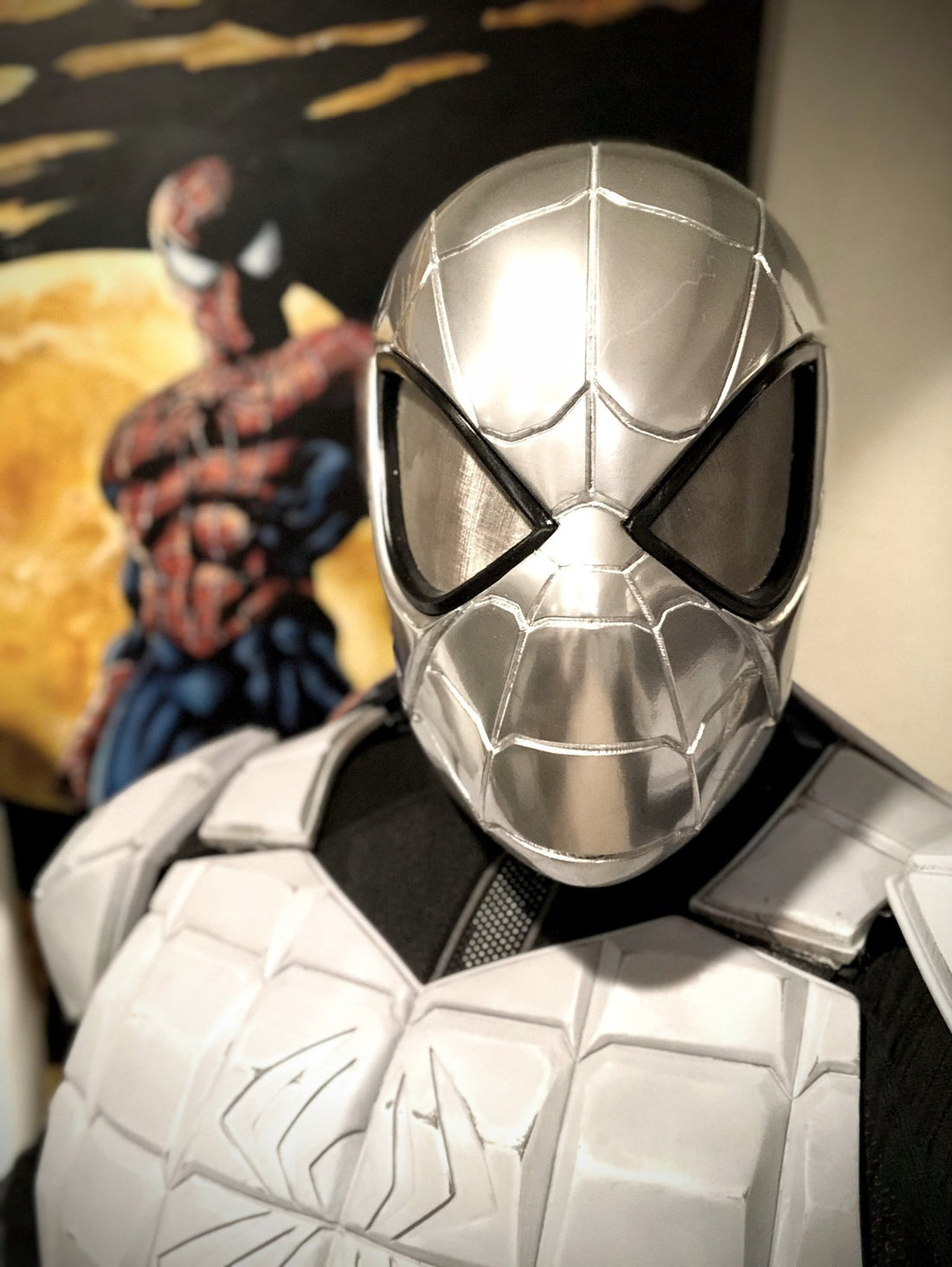
Armored Spider-Man Costume - Part 1
Well, after months and months and months of work, I finally have an Armored Spider-Man costume (Spider Armor MK1) that I can put on! This is something that I've been working on since May 2020, and just now (Dec 2020) am at the point where I can put it on. It's been a ton of work!
This all started because I was cruising Do3D.com for some cool files and came across this great set of files for an Armored Spider-Man suit. I think I even got a discount on it so you know I had to pick it up!

After scaling the armor as best I could using Armorsmith Designer, I printed out and finished the helmet first, then all the armor pieces.

The helmet was easiest because it had a LOT of smooth surfaces and minimal webbing compared to the armor pieces. It was also the most fun and rewarding piece. After sanding it thoroughly, I primered and painted it. Then I printed out the lens "rings", and applied this really cool metal mesh to the inside! This mesh is excellent because unlike other Spider-Man lenses, these won't fog up because there's no need for a reflective film! These are shiny and really fine mesh, yet let air through! I also used some elastic to hold the back piece to the main helmet body, which lets me get my head in and out of the helmet.


I used the Creality CR-10S S4 that I'd purchased from Tiny Machines 3D to print the helmet, shin armor, chest, abs, and back pieces. Luckily this was before all the issues I had with it later as a result of all the upgrades.
I used the Prusa MK3S to print the greeblies like the hand armor, forearms, elbows, back spider, shoulders, tricep, and knee armor.


Once everything was printed out, I spent about a week sanding! I kid you not, this took about a week to sand because of all the little indentations across each piece because of that "webbing" look. It was absolutely horrible! I even used a mouse sander, bondo, and all kinds of sanding tools to make it easier, but it was just a ton of work. I feel like that's all I did throughout the month of May. :) Good thing that due to COVID-19, I wasn't going anywhere!


My process was to sand everything down using the mouse sander, even getting into the web crevices where I could using 150-grit paper. Then I switched to 220-grit sandpaper and hit everything again with the mouse sander. The main goal with the mouse sander is to get rid of as many layer lines as possible. After that, I used some Bondo to put an even layer on the flat surfaces, and mainly to fill in the web crevices where I couldn't really sand out the layer lines. This great Bondo putty helped to fill in those webbing gaps in-between and fix any issues as a result of the 3D-printing process. After application, then I went back in with my 220-grit mouse sander, then sanded the bondo in the crevices by hand and using some sanding files I found on Amazon.

Then came the primer! I use Rustoleum Filler Primer whenever I have these 3D printed objects that look a little rough no matter how much I sand. It works great, and after a few coats really smooths things out! Of course after I'd coated everything, I then took the crucial step to let it sit for 5 months!

No really - I let this all sit for 5 months because I'd picked up a new job and things started to really pick up with the 3D-printing business here at SuperheroDIY! So I just didn't have time to pick this suit back up --- until now!
Once things died down after the holiday season, I was finally able to do some wet-sanding of the primer. I used a 400-grit waterproof sandpaper to do the job, and held each piece of armor under the faucet while I sanded it smooth. The key here is to not sand too much, otherwise you'll just sand off all of that filler primer! And what's the point of that? You want to leave as much filler primer as possible as that is what is making sure that everything is smooth and nice. That's not always easy or reasonable to do all the time, but you do what you can here.
FINALLY - the time came to strap everything together! I went back to Amazon and bought a few different options:
Honestly, I just did it the way I thought it should work. I used the reference photos for the Armored Spider-Man costume models from Do3D to understand how things should be oriented, then used either elastic or the webbing straps along with my hot glue gun to attach things. While this took quite a while and a LOT of hot glue, I was able to get everything strapped together!
If you're looking on a much better way to strap cosplay armor together, check out this great video by @frankly_built.
Of course I did a little test fit of all the armor. I'm noticing that I must have accidentally printed the wrong scale of shin armor, as they are a bit too long and dig into my ankles. I'll have to modify those.

And, I'm noticing that my body type is not quite right for this. While my upper body looks alright due to my broad shoulders, my legs just aren't cuttin' it! With the help of a muscle suit from Flex Design Costumes (the same I've had for years), this suit looks a lot better!

Check out the below gallery of my test-fit of the Armored Spider-Man!
So, what do you think? Anything you would have done differently? Let me know in the comments!
